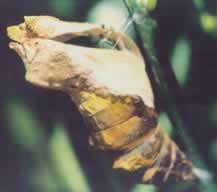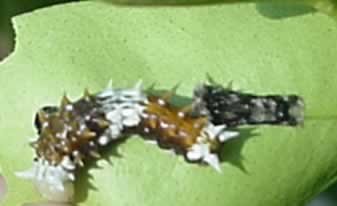|
Moulting Shedding the tough exoskeleton |
|

|
|
When on land, all organisms must protect themselves against dehydration, this above all else is the most important factor to survival. The caterpillar and butterfly are protected from dehydration by a tough, water resistant skin called the cuticle. The cuticle is excreted by the skin and as it dries it hardens. The hardened cuticle will not stretch to accommodate the ever growing caterpillar. So! five times during its lifetime the caterpillar sheds its cuticle as it grows too big for it. The tough, hard cuticle is known as an exoskeleton. Insects, unlike mammals, do not have an internal skeleton to give them shape and protect vital organs. Instead, insects have an exoskeleton that protect vital organs and gives the insect its shape.
Why is it important for the insect to eat the skin it has just shed?
Explain why after shedding its skin the insect will lie in the sun sucking in air?
The butterfly represents the mature stage of the insect. Why does it not shed its skin like the caterpillar does?
What other creatures have an exoskeleton? |
Home of butterflies
